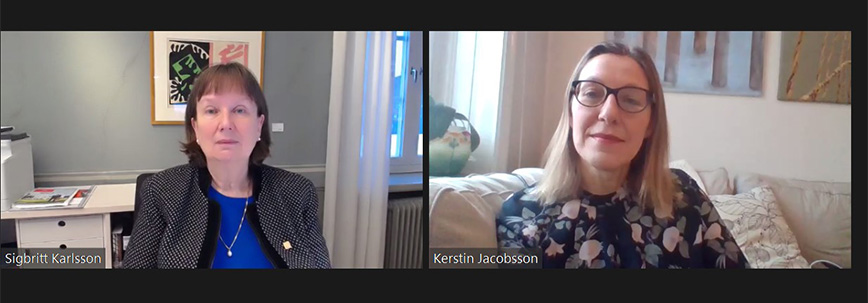The plan for lifting KTH 2021

Education and learning of tomorrow, competitiveness and how cooperation is energising.
These are a few of the things that come up for discussion when Sigbritt Karlsson, President, and Kerstin Jacobsson, University Director, talk about KTH’s strategic development in 2021.
Choosing which initiatives and prioritisations are the most important is not simple whether done face to face or in a 30-minute zoom meeting. In its entirety, this will be crucial for both KTH’s development and involvement. However, several main tracks could still be discussed, based on the 45-page business plan.
“We should offer education that combines digital technology and our tradition with physical campuses – this combination is vital for our competitiveness and offers students greater flexibility, not least by taking onboard the lessons we have learned from the reset over the past year,” says Sigbritt Karlsson.
In the case of research, there are clear goals related to multidisciplinary environments, higher citation rates and continuous quality measuring in the form of evaluations and feedback. The Research Assessment Exercise (RAE) to be performed this year will provide further supporting data for quality development.
Supporting education and research in the best possible ways is our job at GVS (University Administration). The plan is also to make University Administration more efficient via a number of different processes with high participation and homogeny. Your left hand should know what your right hand is doing, and our organisation should become clearer when it comes to roles and responsibilities,” says Jacobsson.
It is also clear from the business plan that KTH’s pillars - internationalisation, equality, sustainable development and digitalisation, continue to form the foundation of and are integral to everything KTH does. According to Karlsson, the plan is to continue working on integrating all the above into research, education and university administration as fully as possible.
KTH is going to start a commission on the future where learning of tomorrow will be top of the agenda. But how does KTH feel here and now?
“KTH is in good health and has enjoyed positive development, despite everything. The past year has taught us new ways and approaches to working together and how well we have been able to acquit ourselves when the chips are down. Crisis management has worked very well and on the whole, we have made decisions at the right time. Despite the circumstances, KTH has developed,” Karlsson says.
“The pandemic has been disruptive and affected the work environment for all of us. Managing the situation quickly became one of my main tasks at University Administration. It has also revealed areas we need to work more with - something that can benefit us over time,” says Jacobsson.
The reorganisation of the schools that began in 2018- is that now completed?
“This must be allowed to take time, not least for the two new schools, but the organisation has started to bed in. Building a common culture takes longer”says Karlsson.
“Things are starting to bed in at GVS too, but how we should work together in the most effective way is something we need to address on a recurring basis” says Jacobsson.
A few wise words for the rest of the year?
“As engineers, many of us are trained in problem-solving which, for natural reasons, means that the focus falls on the problems and sometimes it is easy to forget all the things that we are doing and that are going very well. That is important to remember,” says Karlsson.
“That is exactly right, we need to become less problem-oriented and more development-oriented. Most things work really well, but that does not mean to say they cannot become even better. Good cooperation is also energising,” says Jacobsson, before closing her Zoom window.
Text: Jill Klackenberg

